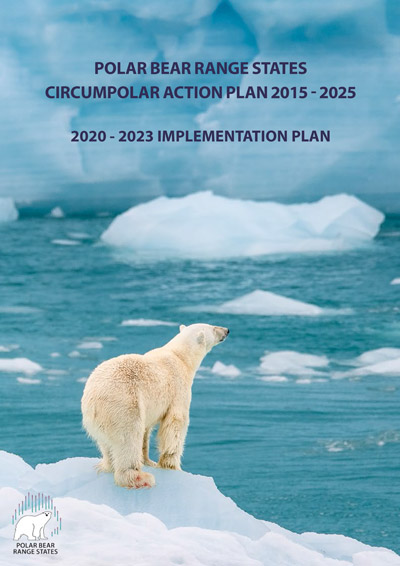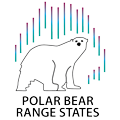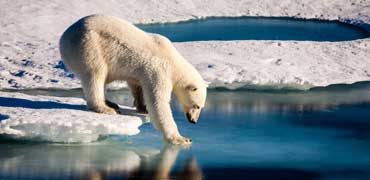 2020-2023 Implementation Plan (click on photo to view introduction pamphlet)The CAP 2020-2023 Implementation Plan (Implementation Plan) was adopted at the 2020 Meeting of the Parties (MoP) to the Polar Bear Range States Agreement, in Longyearbyen, Norway. The Implementation Plan was further developed by the Circumpolar Action Plan Implementation Team (CAP-IT) taking into consideration the progress during the execution of the 2018-2020 Implementation Plan and the recommendations from the Mid Term Review of the 2015-2025 CAP, conducted in 2020.
2020-2023 Implementation Plan (click on photo to view introduction pamphlet)The CAP 2020-2023 Implementation Plan (Implementation Plan) was adopted at the 2020 Meeting of the Parties (MoP) to the Polar Bear Range States Agreement, in Longyearbyen, Norway. The Implementation Plan was further developed by the Circumpolar Action Plan Implementation Team (CAP-IT) taking into consideration the progress during the execution of the 2018-2020 Implementation Plan and the recommendations from the Mid Term Review of the 2015-2025 CAP, conducted in 2020.
The detailed plans and progress reports of each objective and associated actions in the 2020-2023 Implementation Plan are presented on this web-page and the relevant sub-pages.
The overarching vision of the 2015-2025 Circumpolar Action Plan is:
To secure the long-term persistence of polar bears in the wild that represent the genetic, behavioral, life-history and ecological diversity of the species.
In order to realize the vision, the Range States have developed seven key objectives and actions designed to meet the key objectives. The 2020-2023 Implementation Plan addresses six of the seven objectives that will be met through the implementation of 19 actions:
List of Objectives and Actions of the CAP 2020 - 2023 Implementation Plan:
Objective 1 - Track and reduce emerging threats to polar bears
Objective 1 - Track and reduce emerging threats to polar bears
No defined action. All Range States will flag any new or emerging threats to polar bear
Objective 2 - Communicate to the public, policy makers, and legislators around the world the importance of mitigating GHG emissions to polar bear conservation
Objective 2, 2020-2023 Implementation Plan
Objective 2 Actions:
CCC - A2 - Develop a climate change communications plan that outlines key messages (e.g., how climate change effects vary among subpopulations on both temporal and spatial scales, impacts to prey and denning habitat) regarding the threat to the Arctic and to polar bears from climate change and the need for the global community to reduce GHG emissions
CCC - A3 - Identify strategic communications opportunities for the Range States to provide information regarding the threat to the Arctic and to polar bears from climate change and the need for the global community to reduce GHG emissions
CCC - A5 - Enter into climate change communications partnerships with organizations that have targeted audiences and strong public reach
Objective 3 - Ensure the conservation of essential habitat for polar bears
Objective 3, 2020-2023 Implementation Plan
Objective 3 Actions:
EH - A1 - Define categories of essential polar bear habitat and compile existing information to generate an inventory of essential habitat by the categories (and identify gaps in existing information).
EH - A2 - Define levels of protective status of polar bear essential habitat (likely 3 categories)
EH - A7 - Develop messages about the importance of conserving essential habitat
Objective 4 - Ensure that harvest of polar bear subpopulations is managed in a biologically sustainable manner in accordance with sound conservation practices
Objective 4, 2020-2023 Implementation Plan
Objective 4 Actions:
HM - A1 - Define the components necessary for a “quantitative assessment of the population”.
HM - A2 - Define “biologically sustainable harvest” in terms of conserving polar bear subpopulations for future generations.
HM - A3 - Define the components of a “demonstrated sustainable harvest management regime”
Objective 5 - Manage human-bear interactions to ensure human safety and to minimize polar bear injury or mortality
Objective 5, 2020-2023 Implementation Plan
Objective 5 Actions:
HBC - A1 - Make available to all Range States the Polar Bear Human Information Management System (PBHIMS); use SMART where possible
HBCIS - 2 - Make available on the RS website Bear deterrent training protocols from the U.S., Canada, and Norway
HBC - A3 - Establish baseline for bear injuries and deaths using existing data from 2020
HBC - A4 - Establish baseline for human injuries and deaths using existing data from 2006-2015
HBC - A5 - Report findings on human-bear conflicts which end in injury or death (to bears or humans) annually on the RS website for each country or subpopulation
HBC - A6 - Develop standardized polar bear attack response protocols
HBC - A7 - Develop, and post to the RS website, core polar bear safety messages for a general audience and more detailed guidelines for specific user groups (e.g., industry, guide-led tourist groups, hunting/subsistence camps, researchers) as needed
Objective 6 - Ensure that international trade of polar bears is carried out according to conservation principles
Objective 6, 2020-2023 Implementation Plan
Objective 6 Actions:
T - A2 - Review and Analysis of Canadian Trade in Polar Bears from 2012 - 2021
Objective 7 - Carry out coordinated circumpolar population research and monitoring to monitor progress toward achieving the vision of the CAP
Objective 7, 2020-2023 Implementation Plan
Objective 7 Actions:
RMV - A1 - Investigate the feasibility of developing and implementing a long-term plan to monitor the high arctic subpopulation
RMV - A2 - Examine the following two actions, identify studies already conducted/published which address these questions, identify (in collaboration with the PBSG) any appropriate additional studies that could help monitor progress toward achieving the CAP vision:
a. Investigate how climate change effects vary among polar bear subpopulations on both temporal and spatial scales.
b. Conduct a cumulative effects analysis of climate change and human activities on polar bear and their habitats.
2020-2023 Implementation Plan Dashboard - Status overview of actions' deliverables and milestones (lick on image below to download the dashboard)




